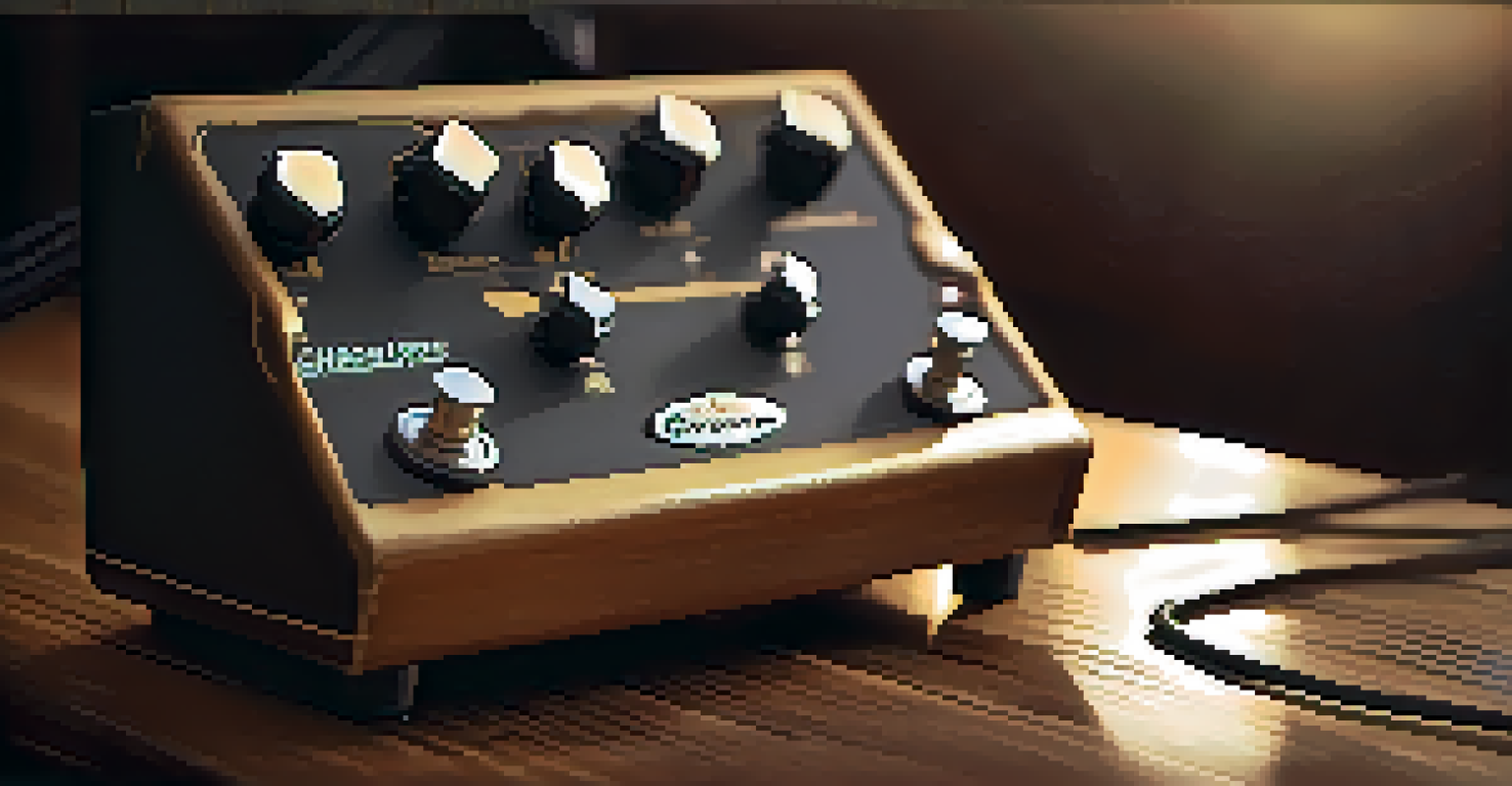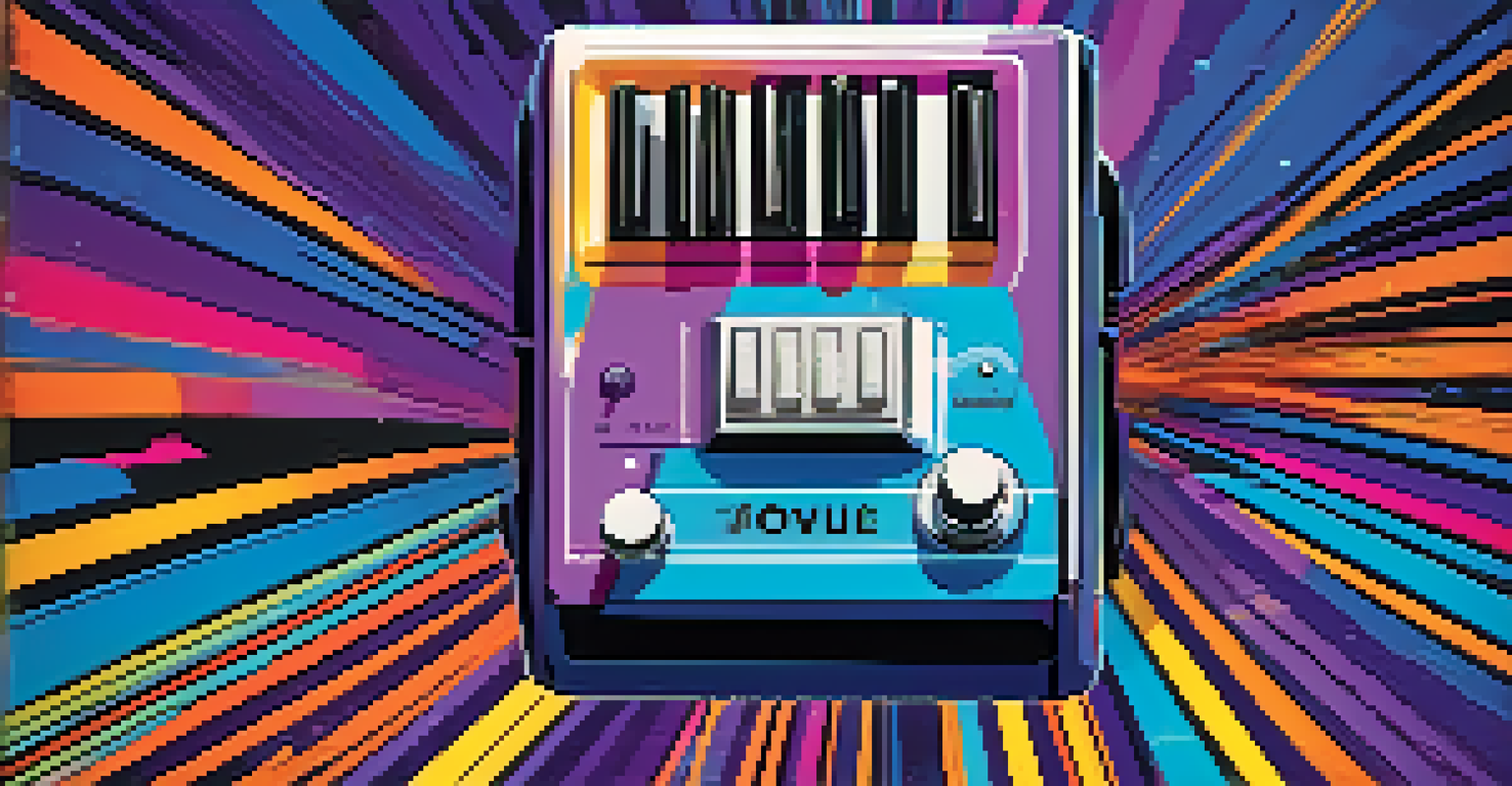Chorus Pedals: Adding Depth and Dimension to Your Sound

Understanding Chorus Pedals and Their Purpose
Chorus pedals are essential tools for musicians looking to enrich their sound. They work by duplicating the audio signal and slightly detuning it, creating a lush, multi-layered effect. This can transform a simple guitar riff or vocal line into something that feels expansive and immersive. Think of it like adding layers of ice cream to a sundae; each scoop enhances the overall flavor.
Music is the shorthand of emotion.
The primary purpose of a chorus pedal is to simulate the effect of multiple instruments playing in unison. This can evoke a sense of fullness and depth that’s often hard to achieve with solo performances. By modulating the pitch and time of the audio signal, chorus pedals can make even the simplest melodies feel grander and more dynamic.
In a live setting or in the studio, chorus pedals can help you stand out. They add an ethereal quality to your sound, making your music more engaging and memorable. Whether you're a guitarist, bassist, or vocalist, incorporating a chorus pedal can elevate your performance.
Key Features of Chorus Pedals to Consider
When choosing a chorus pedal, it's crucial to consider its key features. Most chorus pedals offer controls for depth, rate, and mix, allowing you to tailor the effect to your liking. Depth determines how pronounced the chorus effect is, while rate controls the speed of modulation. The mix knob lets you blend the dry (unaffected) signal with the wet (affected) sound, ensuring you find the perfect balance.

Some pedals also come with additional features like tone controls and different modulation waveforms. These can further shape the overall sound, giving you countless possibilities to explore. For instance, a sine wave provides a smooth modulation, while a square wave can create a more pronounced effect, similar to a shimmering sound.
Chorus Pedals Enrich Sound
Chorus pedals duplicate audio signals and slightly detune them to create a lush, multi-layered effect.
Don’t forget about the form factor and power requirements of the pedal, too. Whether you prefer a compact design for travel or a more robust pedal for studio work, there’s a chorus pedal that fits your needs. Understanding these features will help you find the right pedal to enhance your sound.
Different Types of Chorus Pedals Explained
Chorus pedals come in various types, each with its unique characteristics. Analog chorus pedals use analog circuitry to produce warm, rich tones, often favored for their vintage sound. They tend to have a more organic feel, making them popular among guitarists seeking that classic vibe.
The beautiful thing about learning is that no one can take it away from you.
Digital chorus pedals, on the other hand, utilize digital processing to create a broader range of sounds and effects. They often come packed with features like presets and customizable settings, catering to musicians who crave versatility. This makes them an excellent choice for modern players looking to experiment with their sound.
Then there are hybrid pedals that combine both analog and digital technologies, offering the best of both worlds. They provide the warmth of analog while allowing for the precision of digital effects. By understanding these types, you can choose a chorus pedal that aligns with your musical style.
How to Use a Chorus Pedal Effectively
Using a chorus pedal effectively can enhance your overall sound, but it's essential to know how to set it up. Start by connecting the pedal to your guitar and amp, making sure it’s positioned in the right order in your signal chain, typically before any distortion effects. This ensures the chorus effect is clear and pronounced without being muddied by other effects.
Once connected, begin experimenting with the settings. Start with the depth and rate knobs at moderate positions and adjust from there. A good rule of thumb is to keep the mix knob around halfway to maintain clarity in your sound, gradually increasing it to see how it affects your tone.
Choose Features Wisely
Key features like depth, rate, and mix controls help tailor the chorus effect to fit your musical style.
Lastly, don’t hesitate to try different playing styles while the pedal is engaged. Strumming chords, picking single notes, or even playing harmonics can all yield different results. This experimentation will help you discover the various textures a chorus pedal can provide.
Famous Songs Featuring Chorus Pedals
Many iconic songs have utilized chorus pedals to create memorable sounds. For instance, 'Come As You Are' by Nirvana features a lush chorus effect that contributes to the song’s haunting atmosphere. This is a perfect example of how a chorus pedal can enhance a song's emotional depth.
Another great example is 'Bizarre Love Triangle' by New Order, where the shimmering chorus effect adds to the song’s upbeat, synth-driven vibe. The pedal plays a crucial role in creating that signature sound, making the track instantly recognizable.
By listening to these tracks, you can gain insight into how versatile and impactful a chorus pedal can be. They demonstrate that with the right settings, a chorus pedal can help you achieve a wide range of sonic moods, making your music stand out.
Common Mistakes When Using Chorus Pedals
While chorus pedals can enhance your sound, there are common mistakes musicians make that can detract from the effect. One major error is setting the depth too high, which can lead to a muddy sound. Instead of enriching your tone, it might create a chaotic mix that overwhelms your original signal.
Another mistake is neglecting the mix knob, leading to a sound that’s either too dry or overwhelmingly wet. Finding the right balance is key to ensuring the chorus effect complements your playing rather than overpowers it. Start with a moderate mix and adjust as needed based on the overall context of your performance.
Avoid Common Usage Mistakes
Setting the depth too high or neglecting the mix knob can lead to muddy sounds that detract from your performance.
Lastly, be cautious about using the chorus pedal with other effects. Certain combinations, like heavy distortion, can clash with the chorus and muddy your sound. Experimentation is vital, but keeping these tips in mind will help you avoid common pitfalls.
Caring for Your Chorus Pedal: Maintenance Tips
To ensure your chorus pedal lasts and performs at its best, regular maintenance is essential. Start by keeping it clean; dust and dirt can accumulate over time, affecting its performance. A simple wipe with a soft cloth and occasional use of electronics cleaner can keep your pedal looking and functioning great.
It's also crucial to check the power supply regularly. If you’re using a battery, make sure it’s fresh, as a dying battery can lead to inconsistent performance. For pedals powered by a power supply, ensure the voltage is correct to avoid damage or malfunction.

Finally, store your pedal properly when not in use. Avoid exposing it to extreme temperatures or humidity, which can damage the electronics. By taking these simple steps, you can enjoy your chorus pedal’s rich sound for years to come.